Seoul Secrets: A Royal Journey
Embark on a captivating journey through Seoul's rich history and vibrant culture on this free walking tour, exploring hidden gems and iconic landmarks.
Time
3 Hours
Stops
9 Places
Distance
?
Gyeongbokgung Palace
As the largest of the Five Grand Palaces built during the Joseon Dynasty, Gyeongbokgung offers a glimpse into Korea's royal past and serves as a perfect starting point for exploring Seoul's history.

Gyeongbokgung Palace (Source: Google Maps)
Gyeongbokgung Palace, the largest of the Five Grand Palaces from the Joseon Dynasty, stands as a testament to Korea’s royal heritage. Constructed in 1395, it served as the main palace of the dynasty and is renowned for its beautiful architecture and serene gardens. The palace complex features the iconic Geunjeongjeon Hall, where royal ceremonies were held, and the National Palace Museum of Korea, showcasing artifacts and royal relics. Visitors can witness the changing of the guard ceremony, a colorful display of tradition. The palace grounds also include the tranquil Hyangwonjeong Pavilion, surrounded by a picturesque pond, offering a glimpse into the aesthetic principles of Korean architecture. Gyeongbokgung is not just a historical site; it represents the resilience of Korean culture, having been restored after destruction during the Japanese occupation. It remains a symbol of national pride and a must-visit for anyone wanting to understand Korea’s past.
National Folk Museum of Korea
Located within the grounds of Gyeongbokgung Palace, this museum offers insights into the daily lives and cultural practices of Koreans throughout history.

National Folk Museum of Korea (Source: Google Maps)
Nestled within the grounds of Gyeongbokgung Palace, the National Folk Museum of Korea is dedicated to preserving and showcasing the rich cultural heritage of the Korean people. The museum offers a comprehensive look into the daily lives, traditions, and customs of Koreans throughout history. Established in 1945, it features three main exhibition halls: the History of Korean Life, Korean Folk Beliefs, and Traditional Korean Culture. Visitors can explore artifacts such as traditional clothing, household items, and tools that reflect the evolution of Korean society. The museum also hosts various cultural programs and workshops, providing insights into traditional crafts like pottery and weaving. One of its highlights is the outdoor exhibition area, where traditional Korean houses are reconstructed, offering a glimpse of life in different historical periods. The National Folk Museum serves as an educational hub, making it an essential stop for those interested in understanding the cultural fabric of Korea.
Bukchon Hanok Village
A short walk from the palace, Bukchon Hanok Village is a picturesque area filled with traditional Korean houses, known as hanoks, providing a contrast to the modern cityscape.

Bukchon Hanok Village (Source: Google Maps)
Bukchon Hanok Village is a charming neighborhood that showcases a collection of traditional Korean houses, known as hanoks, dating back to the Joseon Dynasty. Nestled between Gyeongbokgung Palace and Changdeokgung Palace, this village offers a unique glimpse into Korea's architectural heritage. The narrow alleys are lined with beautifully preserved hanoks, featuring distinctive tiled roofs and wooden structures, creating a picturesque setting that contrasts with the modern urban landscape surrounding it. Bukchon is not just a visual treat; it is also a living community where residents engage in traditional crafts and arts. Visitors can explore various cultural centers, workshops, and galleries, where they can learn about traditional Korean crafts such as pottery, weaving, and calligraphy. The village is also famous for its stunning views of the city and nearby palaces, making it a popular spot for photography. Bukchon Hanok Village is a testament to Korea's commitment to preserving its cultural heritage while embracing modernity.
Jogyesa Temple
As the chief temple of the Jogye Order of Korean Buddhism, Jogyesa offers a serene escape and a chance to experience Korean Buddhist culture in the heart of the city.
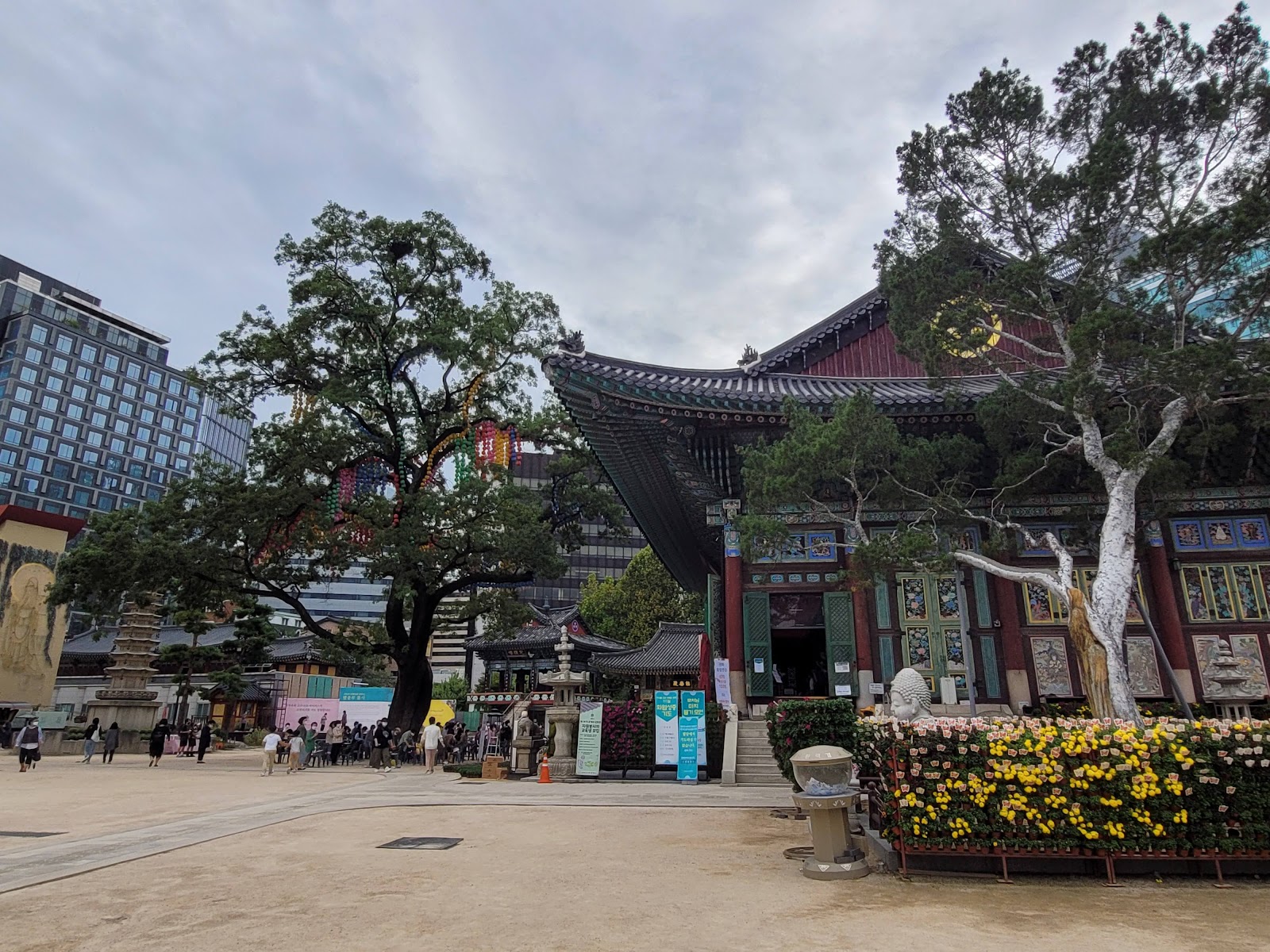
Jogyesa Temple (Source: Google Maps)
Jogyesa Temple, the chief temple of the Jogye Order of Korean Buddhism, stands as a serene oasis in the bustling heart of Seoul. Established in the late 14th century, it has played a vital role in Korean Buddhism and spirituality. The temple is renowned for its beautiful architecture, featuring intricately decorated wooden structures and vibrant lanterns that adorn the grounds, especially during Buddhist holidays. Visitors can witness traditional ceremonies and rituals, providing insight into the practices of Korean Buddhism. The temple’s main hall, Daeungjeon, houses a magnificent statue of the Buddha, attracting both worshippers and tourists. Jogyesa is also a center for cultural activities, offering meditation sessions and teachings on Buddhist philosophy. The surrounding gardens and serene atmosphere make it an ideal spot for reflection and tranquility amidst the city's hustle and bustle. Jogyesa Temple embodies the spiritual essence of Korea and offers a unique perspective on its rich religious traditions.
Insadong Street
Known for its traditional tea houses, art galleries, and antique shops, Insadong is the ideal place to explore traditional Korean culture and crafts.
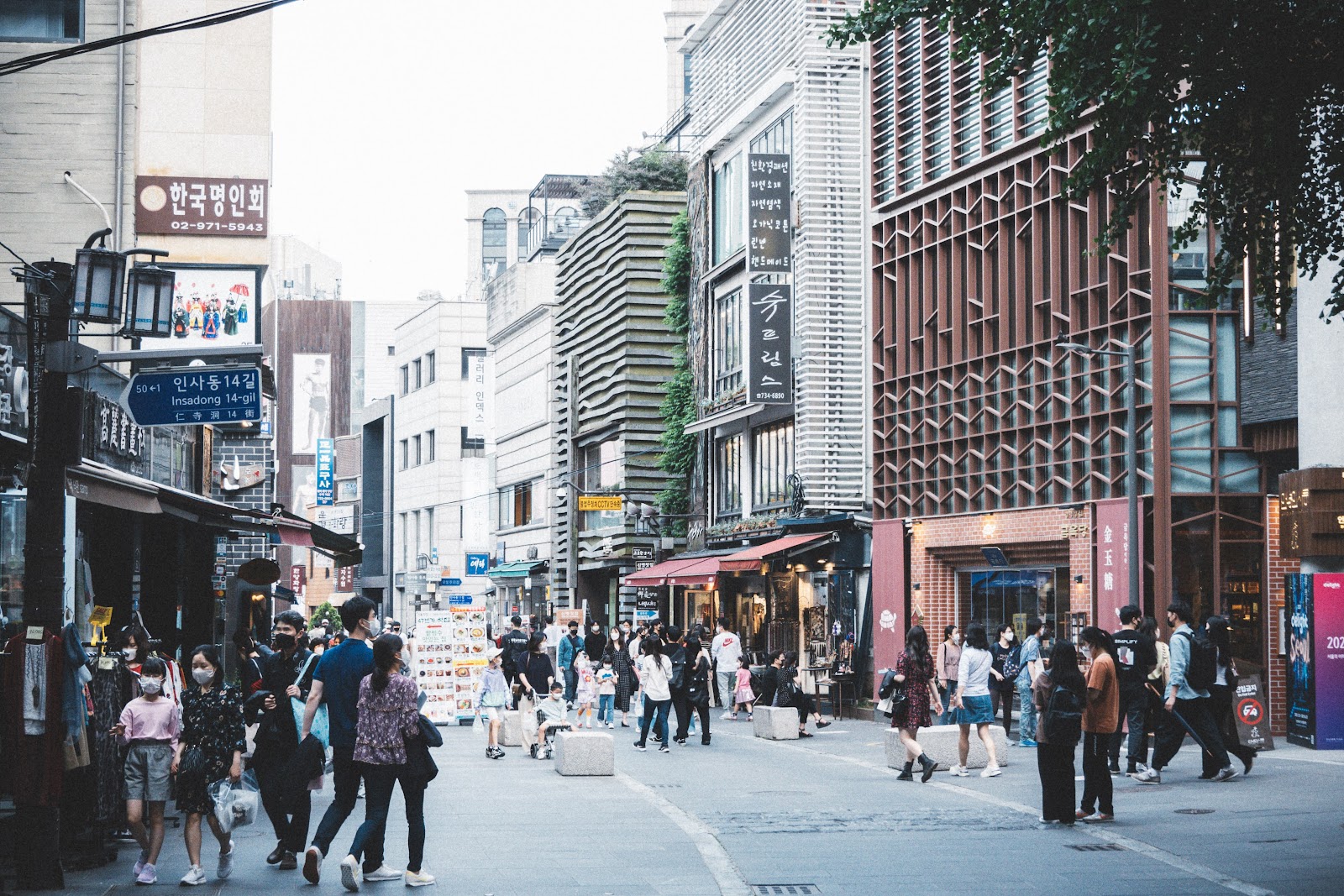
Insadong Street (Source: Google Maps)
Insadong Street is a vibrant cultural district in Seoul, known for its rich blend of traditional Korean culture and modern artistic expressions. This bustling area is lined with traditional tea houses, art galleries, and antique shops, making it a haven for those seeking to experience Korea's artistic heritage. Insadong has a long history as a center for Korean culture and crafts, and it remains a popular destination for both locals and tourists. Visitors can explore a variety of shops offering traditional items such as hanbok (Korean clothing), ceramics, and calligraphy supplies. The street also hosts numerous cultural events and festivals, showcasing traditional music, dance, and art performances. Insadong is particularly famous for its tea houses, where visitors can relax and enjoy traditional Korean tea while soaking in the atmosphere. This district serves as a vibrant reminder of Korea's past and its ongoing commitment to preserving and celebrating its cultural identity.
Tapgol Park
This small park is home to the Wongaksa Pagoda and serves as a historical site where the March 1st Movement for Korean independence was declared.
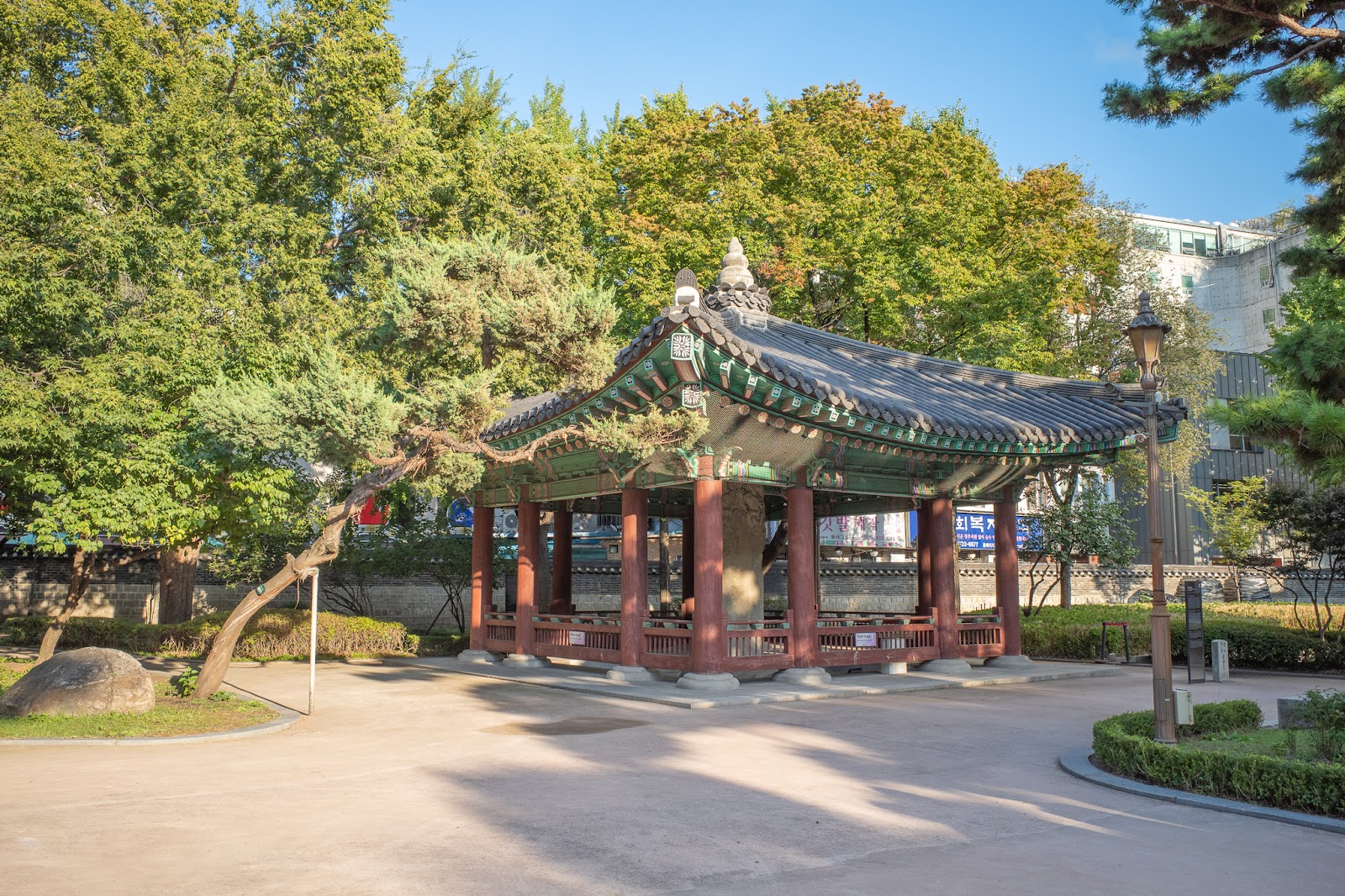
Tapgol Park (Source: Google Maps)
Tapgol Park, a small yet historically significant green space in Seoul, is home to the Wongaksa Pagoda, a national treasure that dates back to the 15th century. The park serves as a crucial landmark in Korean history, as it was here that the March 1st Movement for Korean independence was declared in 1919, marking a pivotal moment in Korea's struggle against Japanese colonial rule. The park features a beautiful pagoda surrounded by lush greenery, providing a peaceful retreat from the urban hustle. In addition to the pagoda, visitors can find several monuments and plaques commemorating the heroes of the independence movement. Tapgol Park has also been a gathering place for various social movements and cultural events, making it a symbol of resilience and hope. Its historical significance, combined with its tranquil atmosphere, makes Tapgol Park a must-visit for anyone interested in understanding Korea's journey towards independence and its cultural heritage.
Cheonggyecheon Stream
This modern urban renewal project offers a peaceful walkway along a restored stream, blending nature with the cityscape.

Cheonggyecheon Stream (Source: Google Maps)
Cheonggyecheon Stream is a remarkable example of urban renewal in Seoul, transforming a once-polluted waterway into a serene and picturesque public space. Spanning approximately 11 kilometers, the stream flows through the heart of the city, providing a tranquil escape amidst the bustling urban environment. The restoration project, completed in 2005, revitalized the area, blending nature with modern architecture. Visitors can stroll along the beautifully landscaped banks, enjoying art installations, waterfalls, and bridges that enhance the scenic beauty of the stream. Cheonggyecheon is not only a recreational space but also a cultural hub, hosting various events and festivals throughout the year, including lantern festivals and art exhibitions. The stream serves as a reminder of Seoul's commitment to sustainable urban development and the importance of preserving natural landscapes within the city. It is a popular spot for both locals and tourists, offering a unique perspective on the harmonious coexistence of nature and urban life.
Gwangjang Market
One of Korea's oldest traditional markets, Gwangjang Market is a bustling hub where you can experience local life and sample traditional Korean street food.
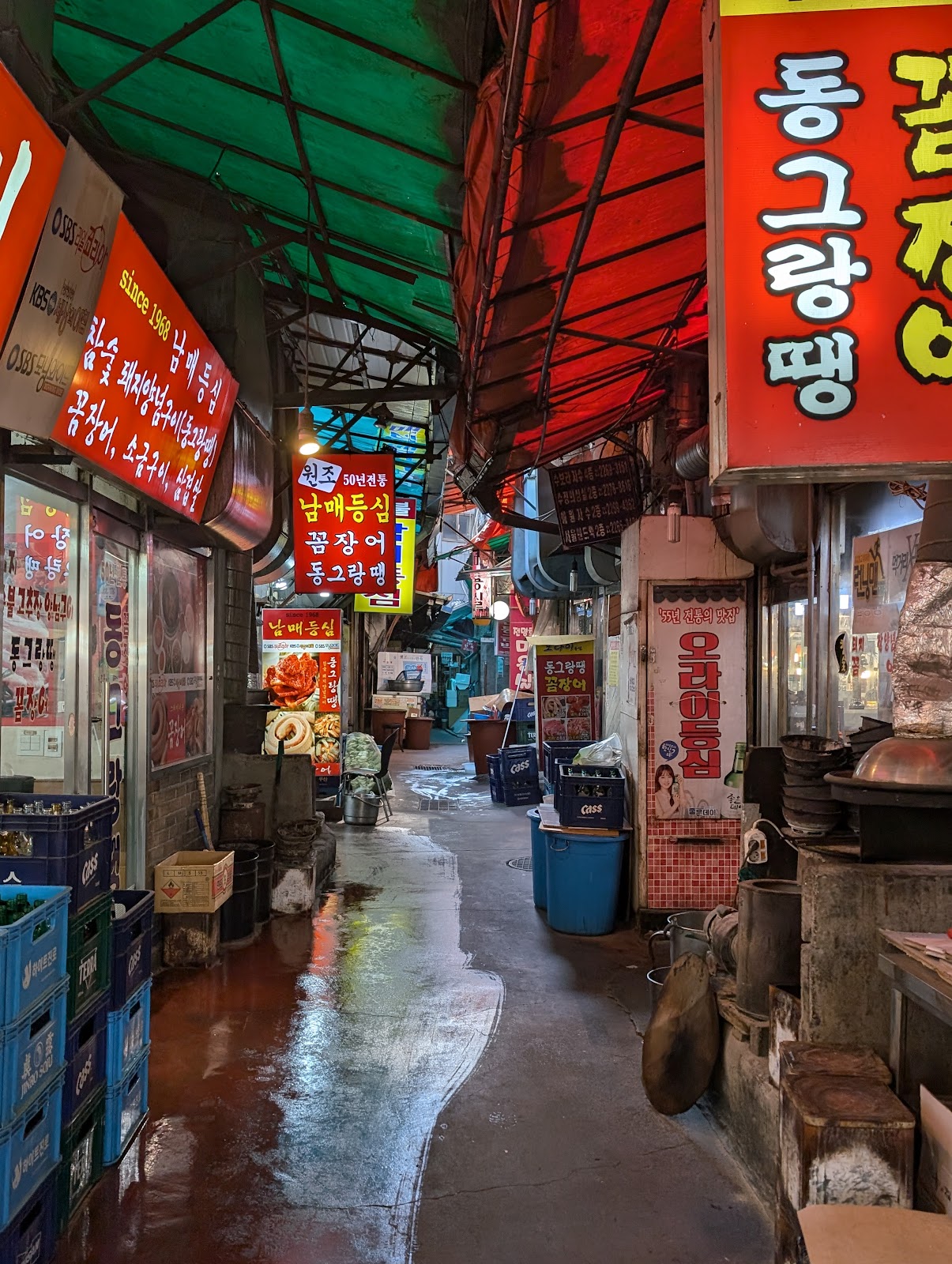
Gwangjang Market (Source: Google Maps)
Gwangjang Market is one of Korea's oldest traditional markets, bustling with life and vibrant energy. Established in 1905, it has become a cultural icon, offering visitors a taste of authentic Korean street food and local life. The market is famous for its wide array of food stalls, where visitors can sample traditional dishes such as bindaetteok (mung bean pancakes), tteokbokki (spicy rice cakes), and various types of kimchi. The market is also known for its textiles, providing a range of silk and linen products, along with traditional hanbok clothing. Gwangjang Market is not just a shopping destination; it is a social hub where locals gather to enjoy food and shop for everyday goods. The lively atmosphere, combined with the aromas of delicious street food, creates an unforgettable experience. Visitors can immerse themselves in the hustle and bustle of market life, making it a perfect spot to experience the heart of Korean culture and culinary traditions.
Dongdaemun Design Plaza (DDP)
Renowned for its futuristic architecture by Zaha Hadid, the DDP is a cultural hub and an icon of modern Seoul, marking the conclusion of your walking tour.
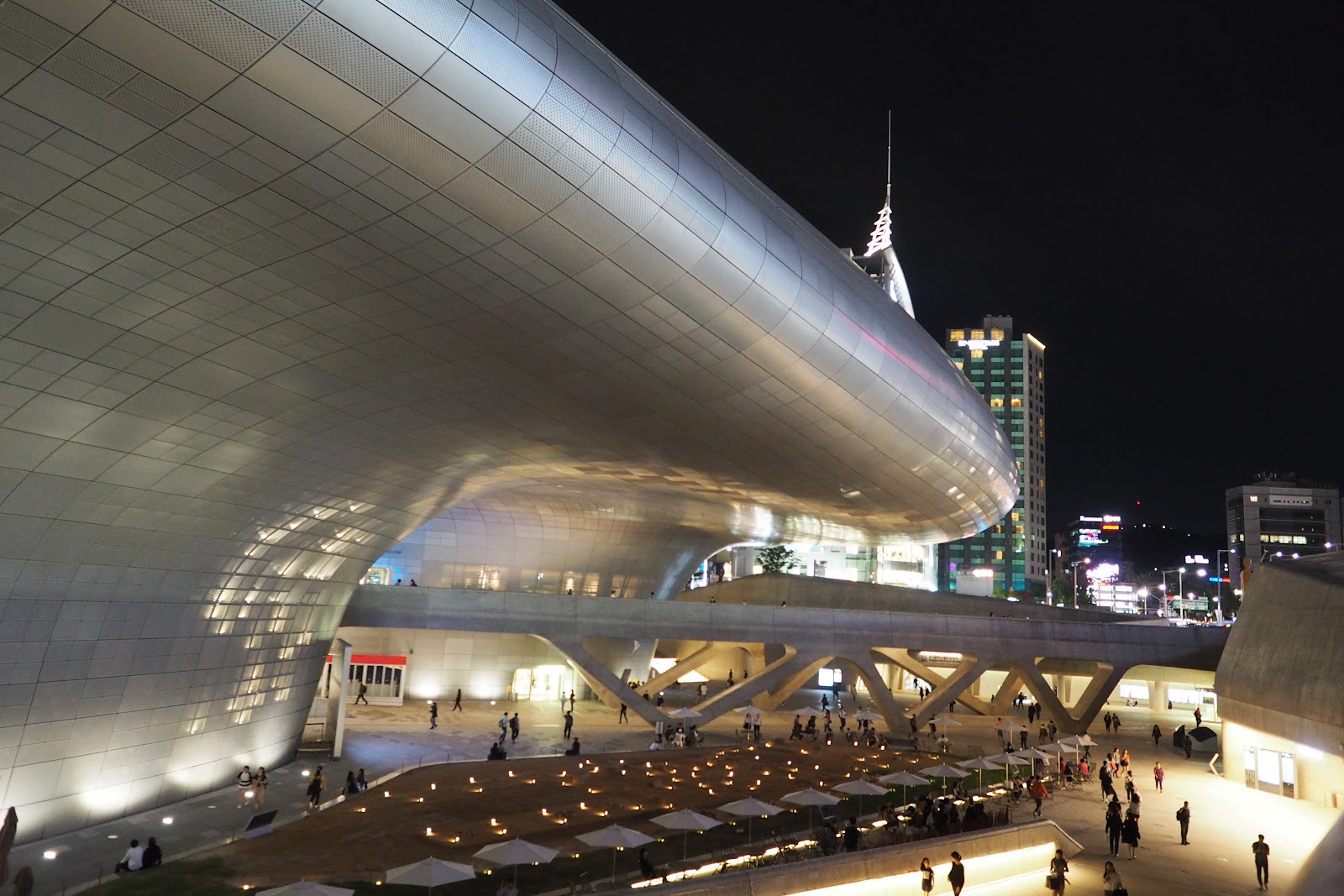
Dongdaemun Design Plaza (DDP) (Source: Google Maps)
Dongdaemun Design Plaza (DDP) is an architectural marvel and a cultural hub in Seoul, designed by the renowned architect Zaha Hadid. Opened in 2014, the DDP is celebrated for its futuristic design, featuring fluid curves and a seamless blend of indoor and outdoor spaces. The plaza serves as a venue for various exhibitions, fashion shows, and cultural events, making it a focal point for design and creativity in the city. The DDP houses a design museum, exhibition halls, and a conference center, attracting designers, artists, and tourists alike. Its iconic LED rose garden, which lights up at night, has become a favorite spot for photography. The DDP is not just a testament to modern architecture but also a reflection of Seoul's dynamic cultural landscape, where tradition meets innovation. It stands as a symbol of the city's commitment to fostering creativity and design, making it a must-visit destination for anyone exploring Seoul.

Your travels, your rules.
Create your own Free Walking Tours.
Set your preferences, distances and anything you want to do or see.
Completely free, no payment required.